Fundamentals of Hospitality & Tourism Report
VerifiedAdded on 2019/11/20
|21
|5209
|244
Report
AI Summary
This report provides a comprehensive overview of the hospitality and tourism industry, tracing its historical development from early forms of travel to modern trends. It examines the evolution of tourism through different eras, highlighting key milestones and changes in travel patterns. The report focuses on New Zealand's tourism landscape, detailing popular destinations and historical landmarks. It also analyzes international visitor arrivals in key countries, discussing the motivations and characteristics of tourists. Furthermore, the report explores significant changes in the tourism and hospitality industry due to globalization, cultural integration, and government initiatives. The changing patterns of travel, including shorter trips and the emergence of new global destinations, are also discussed. The conclusion summarizes the key findings and emphasizes the dynamic nature of the tourism and hospitality sector.
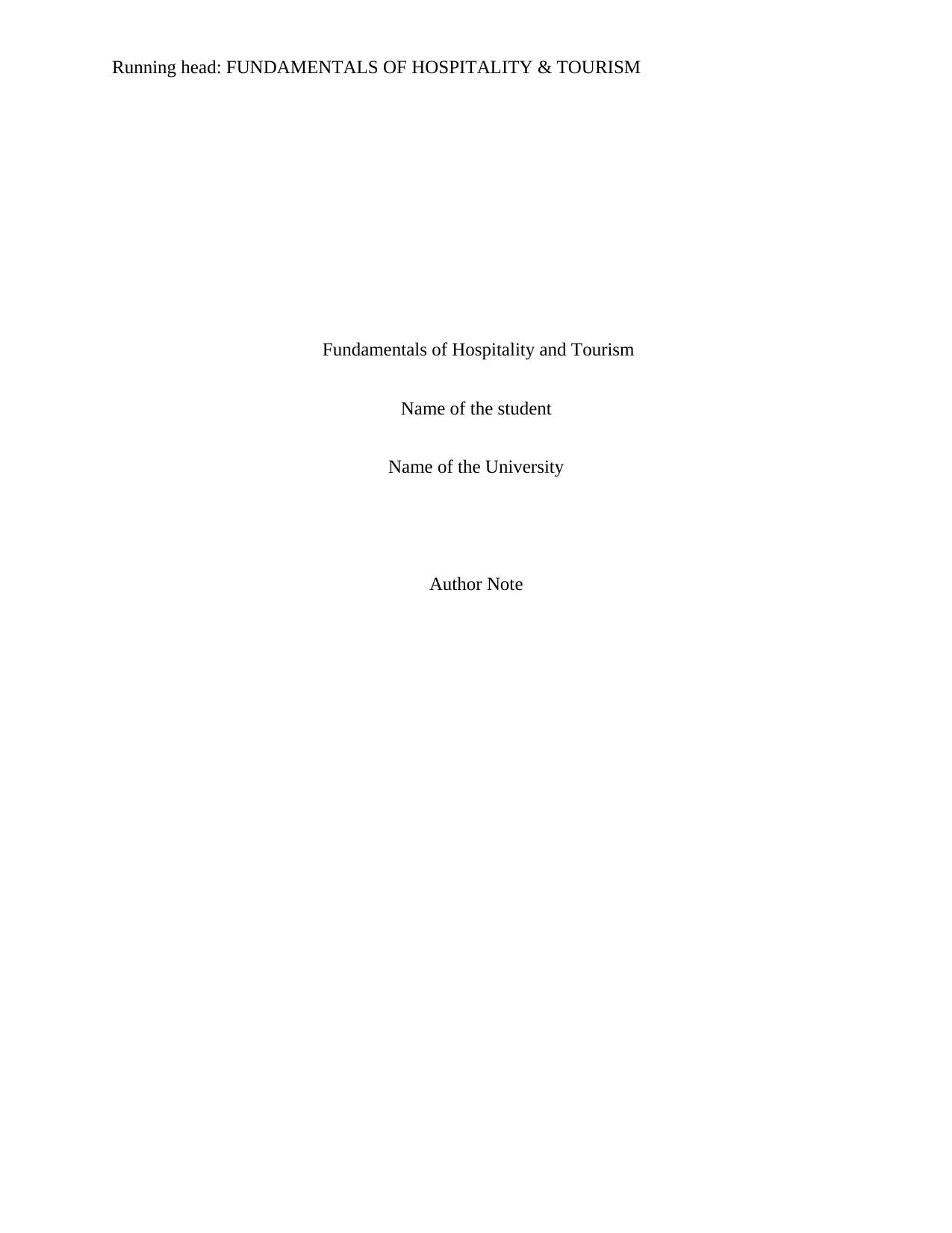
Running head: FUNDAMENTALS OF HOSPITALITY & TOURISM
Fundamentals of Hospitality and Tourism
Name of the student
Name of the University
Author Note
Fundamentals of Hospitality and Tourism
Name of the student
Name of the University
Author Note
Paraphrase This Document
Need a fresh take? Get an instant paraphrase of this document with our AI Paraphraser
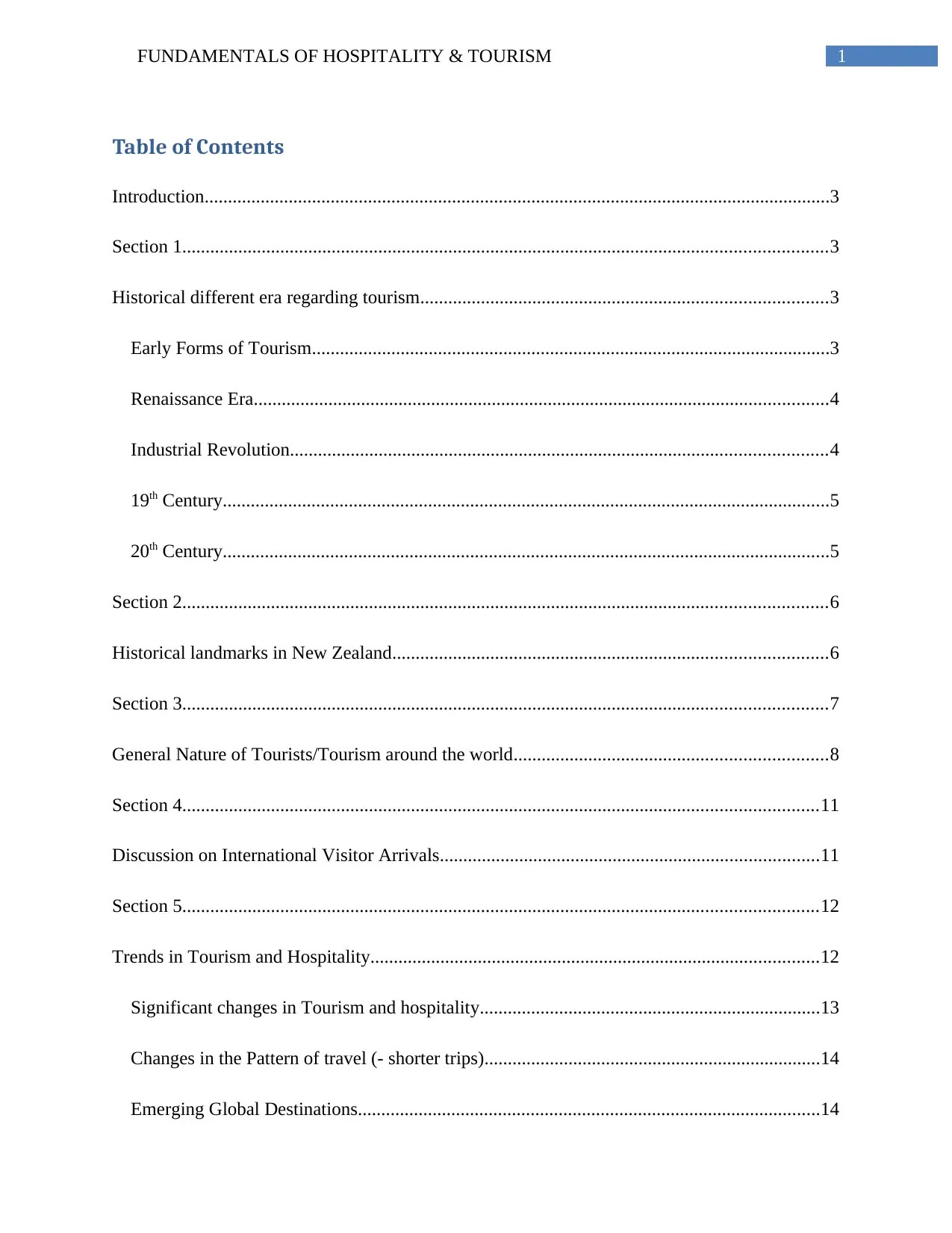
1FUNDAMENTALS OF HOSPITALITY & TOURISM
Table of Contents
Introduction......................................................................................................................................3
Section 1..........................................................................................................................................3
Historical different era regarding tourism.......................................................................................3
Early Forms of Tourism...............................................................................................................3
Renaissance Era...........................................................................................................................4
Industrial Revolution...................................................................................................................4
19th Century..................................................................................................................................5
20th Century..................................................................................................................................5
Section 2..........................................................................................................................................6
Historical landmarks in New Zealand.............................................................................................6
Section 3..........................................................................................................................................7
General Nature of Tourists/Tourism around the world...................................................................8
Section 4........................................................................................................................................11
Discussion on International Visitor Arrivals.................................................................................11
Section 5........................................................................................................................................12
Trends in Tourism and Hospitality................................................................................................12
Significant changes in Tourism and hospitality.........................................................................13
Changes in the Pattern of travel (- shorter trips)........................................................................14
Emerging Global Destinations...................................................................................................14
Table of Contents
Introduction......................................................................................................................................3
Section 1..........................................................................................................................................3
Historical different era regarding tourism.......................................................................................3
Early Forms of Tourism...............................................................................................................3
Renaissance Era...........................................................................................................................4
Industrial Revolution...................................................................................................................4
19th Century..................................................................................................................................5
20th Century..................................................................................................................................5
Section 2..........................................................................................................................................6
Historical landmarks in New Zealand.............................................................................................6
Section 3..........................................................................................................................................7
General Nature of Tourists/Tourism around the world...................................................................8
Section 4........................................................................................................................................11
Discussion on International Visitor Arrivals.................................................................................11
Section 5........................................................................................................................................12
Trends in Tourism and Hospitality................................................................................................12
Significant changes in Tourism and hospitality.........................................................................13
Changes in the Pattern of travel (- shorter trips)........................................................................14
Emerging Global Destinations...................................................................................................14

2FUNDAMENTALS OF HOSPITALITY & TOURISM
Conclusion.....................................................................................................................................15
Reference.......................................................................................................................................17
Conclusion.....................................................................................................................................15
Reference.......................................................................................................................................17
⊘ This is a preview!⊘
Do you want full access?
Subscribe today to unlock all pages.

Trusted by 1+ million students worldwide
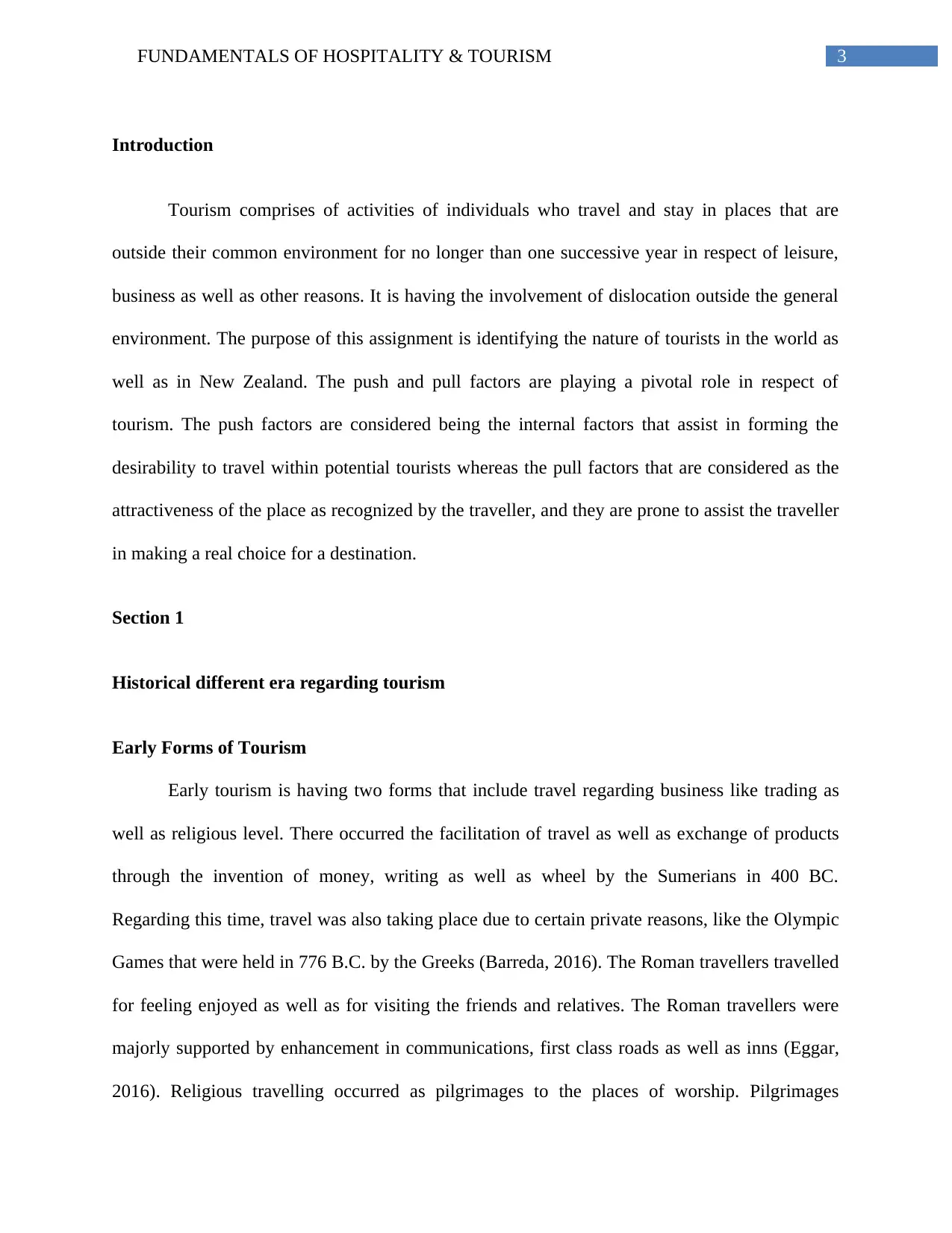
3FUNDAMENTALS OF HOSPITALITY & TOURISM
Introduction
Tourism comprises of activities of individuals who travel and stay in places that are
outside their common environment for no longer than one successive year in respect of leisure,
business as well as other reasons. It is having the involvement of dislocation outside the general
environment. The purpose of this assignment is identifying the nature of tourists in the world as
well as in New Zealand. The push and pull factors are playing a pivotal role in respect of
tourism. The push factors are considered being the internal factors that assist in forming the
desirability to travel within potential tourists whereas the pull factors that are considered as the
attractiveness of the place as recognized by the traveller, and they are prone to assist the traveller
in making a real choice for a destination.
Section 1
Historical different era regarding tourism
Early Forms of Tourism
Early tourism is having two forms that include travel regarding business like trading as
well as religious level. There occurred the facilitation of travel as well as exchange of products
through the invention of money, writing as well as wheel by the Sumerians in 400 BC.
Regarding this time, travel was also taking place due to certain private reasons, like the Olympic
Games that were held in 776 B.C. by the Greeks (Barreda, 2016). The Roman travellers travelled
for feeling enjoyed as well as for visiting the friends and relatives. The Roman travellers were
majorly supported by enhancement in communications, first class roads as well as inns (Eggar,
2016). Religious travelling occurred as pilgrimages to the places of worship. Pilgrimages
Introduction
Tourism comprises of activities of individuals who travel and stay in places that are
outside their common environment for no longer than one successive year in respect of leisure,
business as well as other reasons. It is having the involvement of dislocation outside the general
environment. The purpose of this assignment is identifying the nature of tourists in the world as
well as in New Zealand. The push and pull factors are playing a pivotal role in respect of
tourism. The push factors are considered being the internal factors that assist in forming the
desirability to travel within potential tourists whereas the pull factors that are considered as the
attractiveness of the place as recognized by the traveller, and they are prone to assist the traveller
in making a real choice for a destination.
Section 1
Historical different era regarding tourism
Early Forms of Tourism
Early tourism is having two forms that include travel regarding business like trading as
well as religious level. There occurred the facilitation of travel as well as exchange of products
through the invention of money, writing as well as wheel by the Sumerians in 400 BC.
Regarding this time, travel was also taking place due to certain private reasons, like the Olympic
Games that were held in 776 B.C. by the Greeks (Barreda, 2016). The Roman travellers travelled
for feeling enjoyed as well as for visiting the friends and relatives. The Roman travellers were
majorly supported by enhancement in communications, first class roads as well as inns (Eggar,
2016). Religious travelling occurred as pilgrimages to the places of worship. Pilgrimages
Paraphrase This Document
Need a fresh take? Get an instant paraphrase of this document with our AI Paraphraser
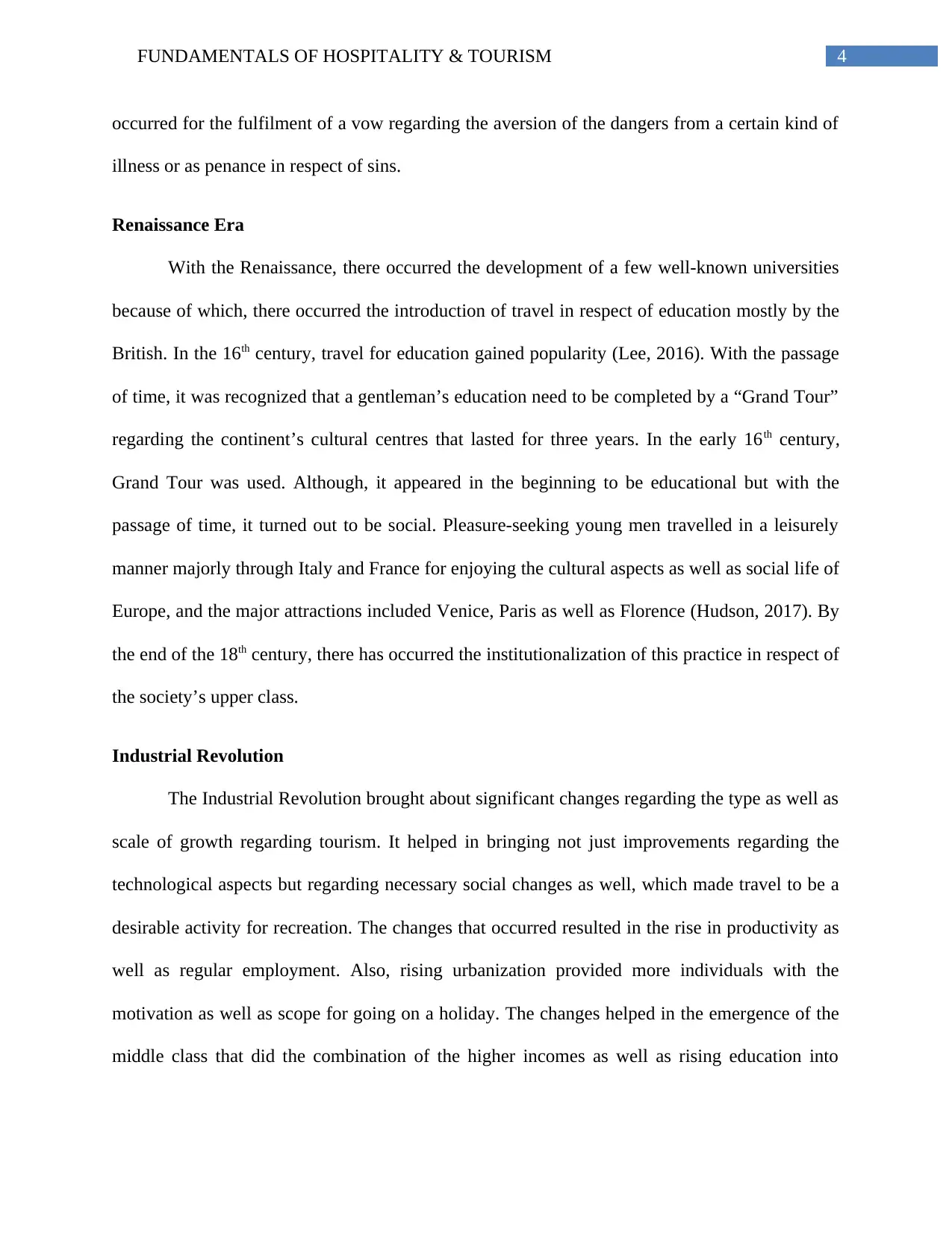
4FUNDAMENTALS OF HOSPITALITY & TOURISM
occurred for the fulfilment of a vow regarding the aversion of the dangers from a certain kind of
illness or as penance in respect of sins.
Renaissance Era
With the Renaissance, there occurred the development of a few well-known universities
because of which, there occurred the introduction of travel in respect of education mostly by the
British. In the 16th century, travel for education gained popularity (Lee, 2016). With the passage
of time, it was recognized that a gentleman’s education need to be completed by a “Grand Tour”
regarding the continent’s cultural centres that lasted for three years. In the early 16th century,
Grand Tour was used. Although, it appeared in the beginning to be educational but with the
passage of time, it turned out to be social. Pleasure-seeking young men travelled in a leisurely
manner majorly through Italy and France for enjoying the cultural aspects as well as social life of
Europe, and the major attractions included Venice, Paris as well as Florence (Hudson, 2017). By
the end of the 18th century, there has occurred the institutionalization of this practice in respect of
the society’s upper class.
Industrial Revolution
The Industrial Revolution brought about significant changes regarding the type as well as
scale of growth regarding tourism. It helped in bringing not just improvements regarding the
technological aspects but regarding necessary social changes as well, which made travel to be a
desirable activity for recreation. The changes that occurred resulted in the rise in productivity as
well as regular employment. Also, rising urbanization provided more individuals with the
motivation as well as scope for going on a holiday. The changes helped in the emergence of the
middle class that did the combination of the higher incomes as well as rising education into
occurred for the fulfilment of a vow regarding the aversion of the dangers from a certain kind of
illness or as penance in respect of sins.
Renaissance Era
With the Renaissance, there occurred the development of a few well-known universities
because of which, there occurred the introduction of travel in respect of education mostly by the
British. In the 16th century, travel for education gained popularity (Lee, 2016). With the passage
of time, it was recognized that a gentleman’s education need to be completed by a “Grand Tour”
regarding the continent’s cultural centres that lasted for three years. In the early 16th century,
Grand Tour was used. Although, it appeared in the beginning to be educational but with the
passage of time, it turned out to be social. Pleasure-seeking young men travelled in a leisurely
manner majorly through Italy and France for enjoying the cultural aspects as well as social life of
Europe, and the major attractions included Venice, Paris as well as Florence (Hudson, 2017). By
the end of the 18th century, there has occurred the institutionalization of this practice in respect of
the society’s upper class.
Industrial Revolution
The Industrial Revolution brought about significant changes regarding the type as well as
scale of growth regarding tourism. It helped in bringing not just improvements regarding the
technological aspects but regarding necessary social changes as well, which made travel to be a
desirable activity for recreation. The changes that occurred resulted in the rise in productivity as
well as regular employment. Also, rising urbanization provided more individuals with the
motivation as well as scope for going on a holiday. The changes helped in the emergence of the
middle class that did the combination of the higher incomes as well as rising education into
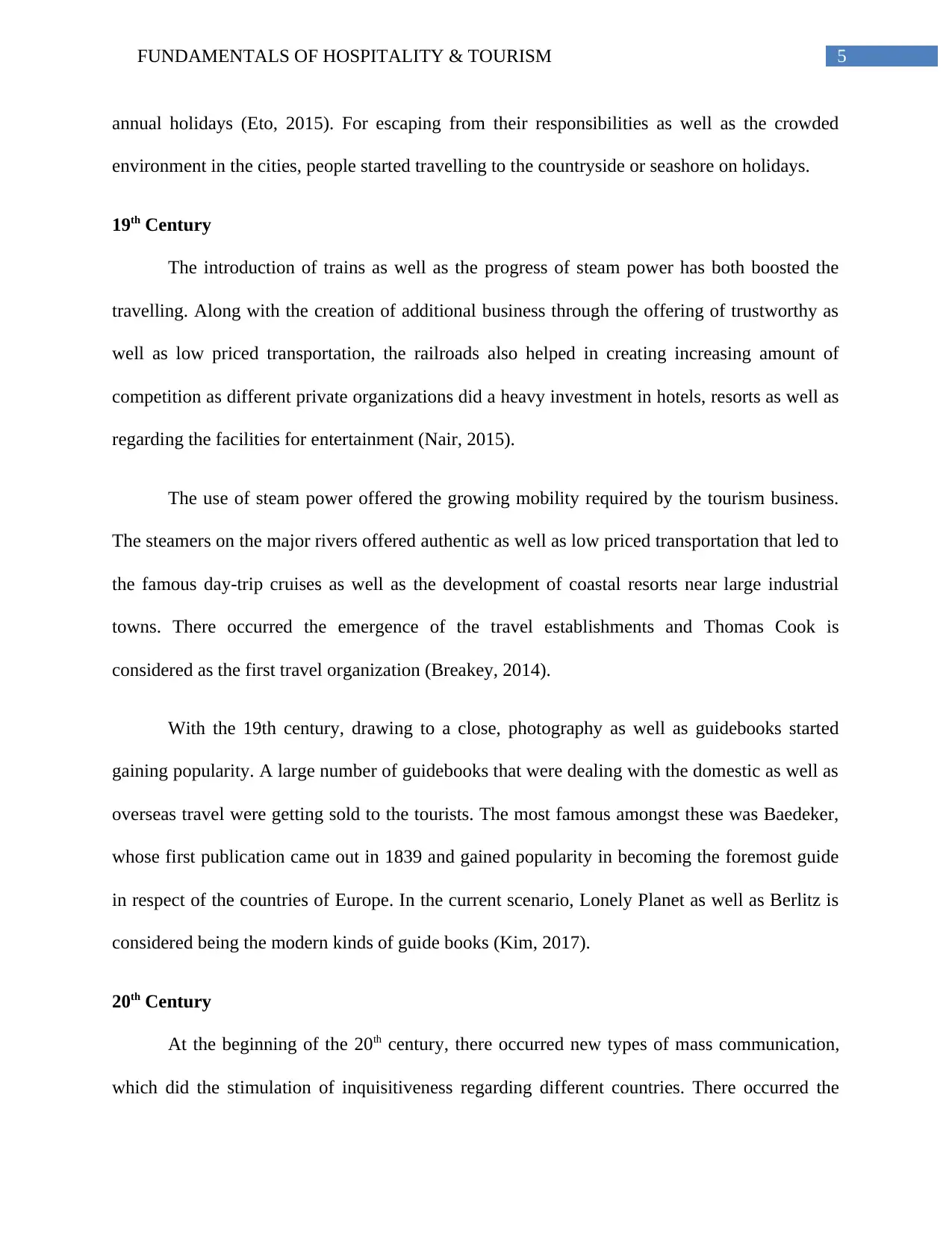
5FUNDAMENTALS OF HOSPITALITY & TOURISM
annual holidays (Eto, 2015). For escaping from their responsibilities as well as the crowded
environment in the cities, people started travelling to the countryside or seashore on holidays.
19th Century
The introduction of trains as well as the progress of steam power has both boosted the
travelling. Along with the creation of additional business through the offering of trustworthy as
well as low priced transportation, the railroads also helped in creating increasing amount of
competition as different private organizations did a heavy investment in hotels, resorts as well as
regarding the facilities for entertainment (Nair, 2015).
The use of steam power offered the growing mobility required by the tourism business.
The steamers on the major rivers offered authentic as well as low priced transportation that led to
the famous day-trip cruises as well as the development of coastal resorts near large industrial
towns. There occurred the emergence of the travel establishments and Thomas Cook is
considered as the first travel organization (Breakey, 2014).
With the 19th century, drawing to a close, photography as well as guidebooks started
gaining popularity. A large number of guidebooks that were dealing with the domestic as well as
overseas travel were getting sold to the tourists. The most famous amongst these was Baedeker,
whose first publication came out in 1839 and gained popularity in becoming the foremost guide
in respect of the countries of Europe. In the current scenario, Lonely Planet as well as Berlitz is
considered being the modern kinds of guide books (Kim, 2017).
20th Century
At the beginning of the 20th century, there occurred new types of mass communication,
which did the stimulation of inquisitiveness regarding different countries. There occurred the
annual holidays (Eto, 2015). For escaping from their responsibilities as well as the crowded
environment in the cities, people started travelling to the countryside or seashore on holidays.
19th Century
The introduction of trains as well as the progress of steam power has both boosted the
travelling. Along with the creation of additional business through the offering of trustworthy as
well as low priced transportation, the railroads also helped in creating increasing amount of
competition as different private organizations did a heavy investment in hotels, resorts as well as
regarding the facilities for entertainment (Nair, 2015).
The use of steam power offered the growing mobility required by the tourism business.
The steamers on the major rivers offered authentic as well as low priced transportation that led to
the famous day-trip cruises as well as the development of coastal resorts near large industrial
towns. There occurred the emergence of the travel establishments and Thomas Cook is
considered as the first travel organization (Breakey, 2014).
With the 19th century, drawing to a close, photography as well as guidebooks started
gaining popularity. A large number of guidebooks that were dealing with the domestic as well as
overseas travel were getting sold to the tourists. The most famous amongst these was Baedeker,
whose first publication came out in 1839 and gained popularity in becoming the foremost guide
in respect of the countries of Europe. In the current scenario, Lonely Planet as well as Berlitz is
considered being the modern kinds of guide books (Kim, 2017).
20th Century
At the beginning of the 20th century, there occurred new types of mass communication,
which did the stimulation of inquisitiveness regarding different countries. There occurred the
⊘ This is a preview!⊘
Do you want full access?
Subscribe today to unlock all pages.

Trusted by 1+ million students worldwide
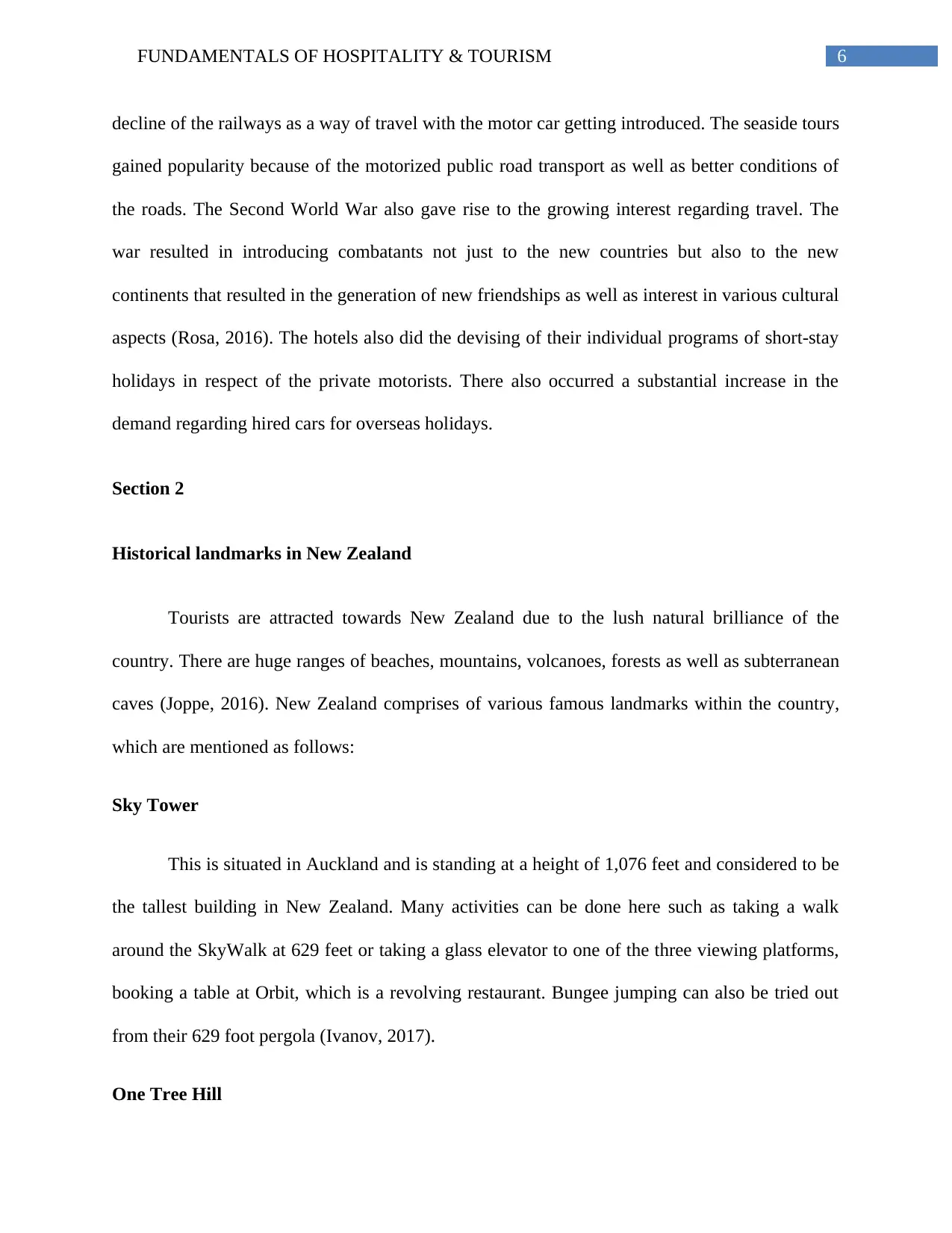
6FUNDAMENTALS OF HOSPITALITY & TOURISM
decline of the railways as a way of travel with the motor car getting introduced. The seaside tours
gained popularity because of the motorized public road transport as well as better conditions of
the roads. The Second World War also gave rise to the growing interest regarding travel. The
war resulted in introducing combatants not just to the new countries but also to the new
continents that resulted in the generation of new friendships as well as interest in various cultural
aspects (Rosa, 2016). The hotels also did the devising of their individual programs of short-stay
holidays in respect of the private motorists. There also occurred a substantial increase in the
demand regarding hired cars for overseas holidays.
Section 2
Historical landmarks in New Zealand
Tourists are attracted towards New Zealand due to the lush natural brilliance of the
country. There are huge ranges of beaches, mountains, volcanoes, forests as well as subterranean
caves (Joppe, 2016). New Zealand comprises of various famous landmarks within the country,
which are mentioned as follows:
Sky Tower
This is situated in Auckland and is standing at a height of 1,076 feet and considered to be
the tallest building in New Zealand. Many activities can be done here such as taking a walk
around the SkyWalk at 629 feet or taking a glass elevator to one of the three viewing platforms,
booking a table at Orbit, which is a revolving restaurant. Bungee jumping can also be tried out
from their 629 foot pergola (Ivanov, 2017).
One Tree Hill
decline of the railways as a way of travel with the motor car getting introduced. The seaside tours
gained popularity because of the motorized public road transport as well as better conditions of
the roads. The Second World War also gave rise to the growing interest regarding travel. The
war resulted in introducing combatants not just to the new countries but also to the new
continents that resulted in the generation of new friendships as well as interest in various cultural
aspects (Rosa, 2016). The hotels also did the devising of their individual programs of short-stay
holidays in respect of the private motorists. There also occurred a substantial increase in the
demand regarding hired cars for overseas holidays.
Section 2
Historical landmarks in New Zealand
Tourists are attracted towards New Zealand due to the lush natural brilliance of the
country. There are huge ranges of beaches, mountains, volcanoes, forests as well as subterranean
caves (Joppe, 2016). New Zealand comprises of various famous landmarks within the country,
which are mentioned as follows:
Sky Tower
This is situated in Auckland and is standing at a height of 1,076 feet and considered to be
the tallest building in New Zealand. Many activities can be done here such as taking a walk
around the SkyWalk at 629 feet or taking a glass elevator to one of the three viewing platforms,
booking a table at Orbit, which is a revolving restaurant. Bungee jumping can also be tried out
from their 629 foot pergola (Ivanov, 2017).
One Tree Hill
Paraphrase This Document
Need a fresh take? Get an instant paraphrase of this document with our AI Paraphraser
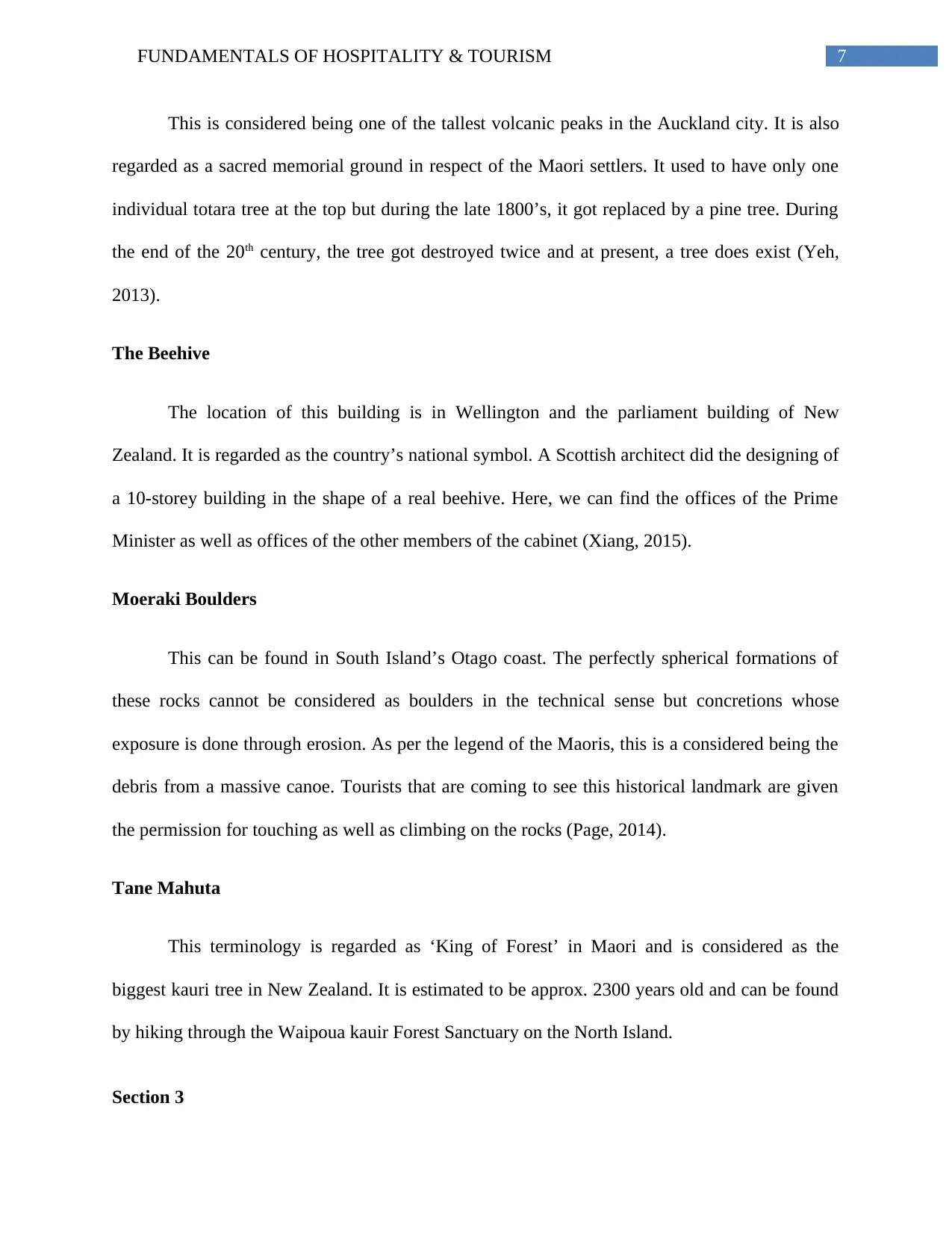
7FUNDAMENTALS OF HOSPITALITY & TOURISM
This is considered being one of the tallest volcanic peaks in the Auckland city. It is also
regarded as a sacred memorial ground in respect of the Maori settlers. It used to have only one
individual totara tree at the top but during the late 1800’s, it got replaced by a pine tree. During
the end of the 20th century, the tree got destroyed twice and at present, a tree does exist (Yeh,
2013).
The Beehive
The location of this building is in Wellington and the parliament building of New
Zealand. It is regarded as the country’s national symbol. A Scottish architect did the designing of
a 10-storey building in the shape of a real beehive. Here, we can find the offices of the Prime
Minister as well as offices of the other members of the cabinet (Xiang, 2015).
Moeraki Boulders
This can be found in South Island’s Otago coast. The perfectly spherical formations of
these rocks cannot be considered as boulders in the technical sense but concretions whose
exposure is done through erosion. As per the legend of the Maoris, this is a considered being the
debris from a massive canoe. Tourists that are coming to see this historical landmark are given
the permission for touching as well as climbing on the rocks (Page, 2014).
Tane Mahuta
This terminology is regarded as ‘King of Forest’ in Maori and is considered as the
biggest kauri tree in New Zealand. It is estimated to be approx. 2300 years old and can be found
by hiking through the Waipoua kauir Forest Sanctuary on the North Island.
Section 3
This is considered being one of the tallest volcanic peaks in the Auckland city. It is also
regarded as a sacred memorial ground in respect of the Maori settlers. It used to have only one
individual totara tree at the top but during the late 1800’s, it got replaced by a pine tree. During
the end of the 20th century, the tree got destroyed twice and at present, a tree does exist (Yeh,
2013).
The Beehive
The location of this building is in Wellington and the parliament building of New
Zealand. It is regarded as the country’s national symbol. A Scottish architect did the designing of
a 10-storey building in the shape of a real beehive. Here, we can find the offices of the Prime
Minister as well as offices of the other members of the cabinet (Xiang, 2015).
Moeraki Boulders
This can be found in South Island’s Otago coast. The perfectly spherical formations of
these rocks cannot be considered as boulders in the technical sense but concretions whose
exposure is done through erosion. As per the legend of the Maoris, this is a considered being the
debris from a massive canoe. Tourists that are coming to see this historical landmark are given
the permission for touching as well as climbing on the rocks (Page, 2014).
Tane Mahuta
This terminology is regarded as ‘King of Forest’ in Maori and is considered as the
biggest kauri tree in New Zealand. It is estimated to be approx. 2300 years old and can be found
by hiking through the Waipoua kauir Forest Sanctuary on the North Island.
Section 3
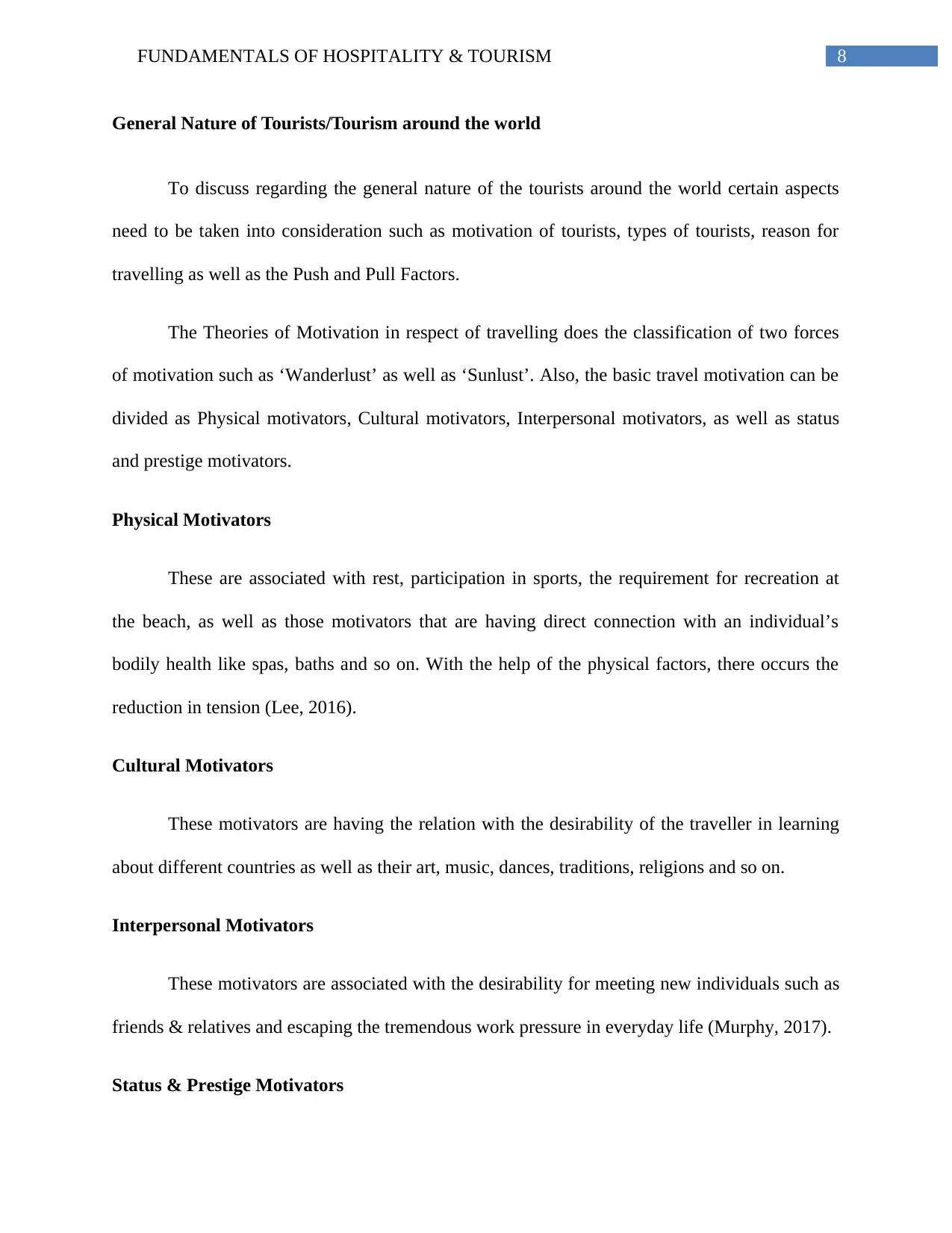
8FUNDAMENTALS OF HOSPITALITY & TOURISM
General Nature of Tourists/Tourism around the world
To discuss regarding the general nature of the tourists around the world certain aspects
need to be taken into consideration such as motivation of tourists, types of tourists, reason for
travelling as well as the Push and Pull Factors.
The Theories of Motivation in respect of travelling does the classification of two forces
of motivation such as ‘Wanderlust’ as well as ‘Sunlust’. Also, the basic travel motivation can be
divided as Physical motivators, Cultural motivators, Interpersonal motivators, as well as status
and prestige motivators.
Physical Motivators
These are associated with rest, participation in sports, the requirement for recreation at
the beach, as well as those motivators that are having direct connection with an individual’s
bodily health like spas, baths and so on. With the help of the physical factors, there occurs the
reduction in tension (Lee, 2016).
Cultural Motivators
These motivators are having the relation with the desirability of the traveller in learning
about different countries as well as their art, music, dances, traditions, religions and so on.
Interpersonal Motivators
These motivators are associated with the desirability for meeting new individuals such as
friends & relatives and escaping the tremendous work pressure in everyday life (Murphy, 2017).
Status & Prestige Motivators
General Nature of Tourists/Tourism around the world
To discuss regarding the general nature of the tourists around the world certain aspects
need to be taken into consideration such as motivation of tourists, types of tourists, reason for
travelling as well as the Push and Pull Factors.
The Theories of Motivation in respect of travelling does the classification of two forces
of motivation such as ‘Wanderlust’ as well as ‘Sunlust’. Also, the basic travel motivation can be
divided as Physical motivators, Cultural motivators, Interpersonal motivators, as well as status
and prestige motivators.
Physical Motivators
These are associated with rest, participation in sports, the requirement for recreation at
the beach, as well as those motivators that are having direct connection with an individual’s
bodily health like spas, baths and so on. With the help of the physical factors, there occurs the
reduction in tension (Lee, 2016).
Cultural Motivators
These motivators are having the relation with the desirability of the traveller in learning
about different countries as well as their art, music, dances, traditions, religions and so on.
Interpersonal Motivators
These motivators are associated with the desirability for meeting new individuals such as
friends & relatives and escaping the tremendous work pressure in everyday life (Murphy, 2017).
Status & Prestige Motivators
⊘ This is a preview!⊘
Do you want full access?
Subscribe today to unlock all pages.

Trusted by 1+ million students worldwide
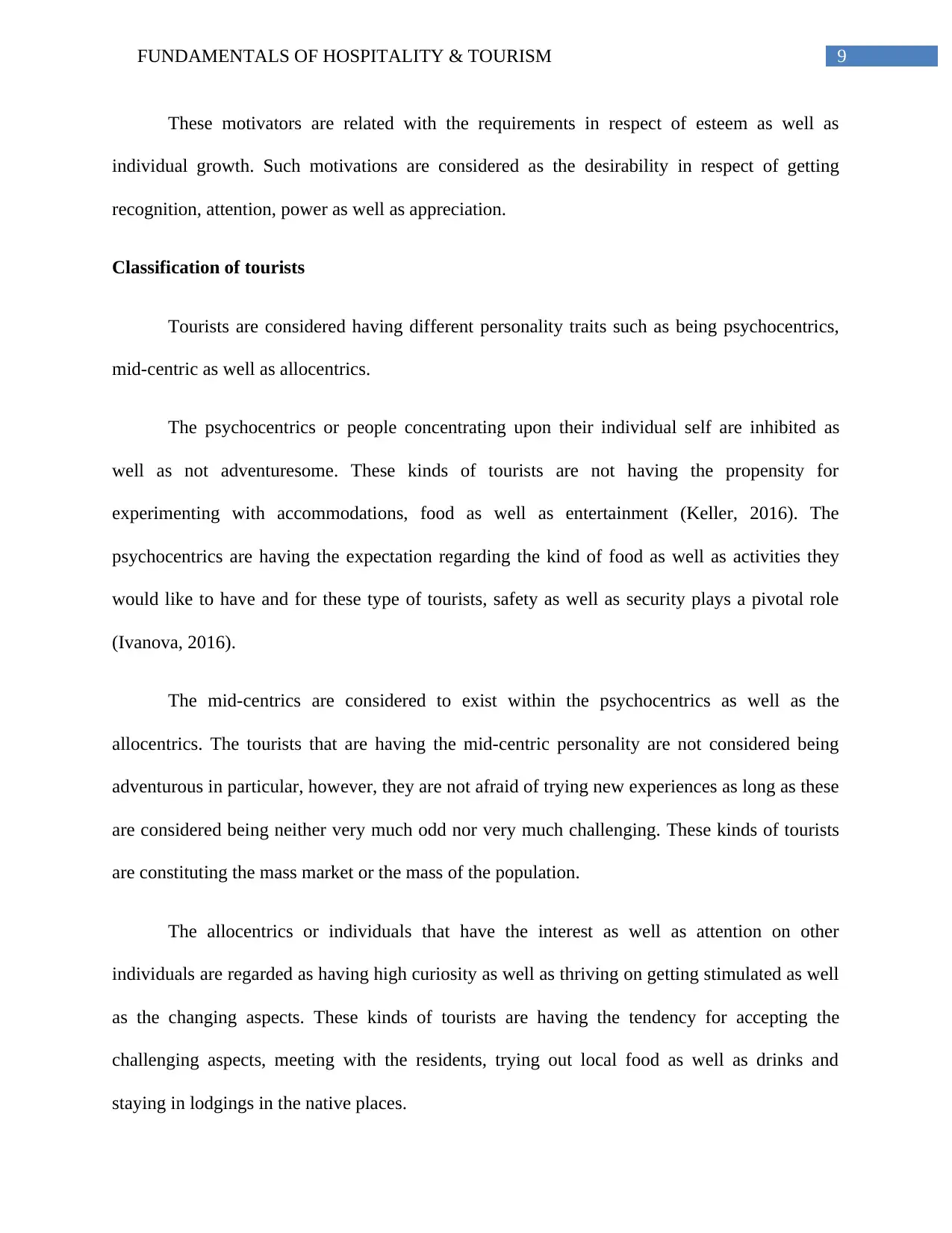
9FUNDAMENTALS OF HOSPITALITY & TOURISM
These motivators are related with the requirements in respect of esteem as well as
individual growth. Such motivations are considered as the desirability in respect of getting
recognition, attention, power as well as appreciation.
Classification of tourists
Tourists are considered having different personality traits such as being psychocentrics,
mid-centric as well as allocentrics.
The psychocentrics or people concentrating upon their individual self are inhibited as
well as not adventuresome. These kinds of tourists are not having the propensity for
experimenting with accommodations, food as well as entertainment (Keller, 2016). The
psychocentrics are having the expectation regarding the kind of food as well as activities they
would like to have and for these type of tourists, safety as well as security plays a pivotal role
(Ivanova, 2016).
The mid-centrics are considered to exist within the psychocentrics as well as the
allocentrics. The tourists that are having the mid-centric personality are not considered being
adventurous in particular, however, they are not afraid of trying new experiences as long as these
are considered being neither very much odd nor very much challenging. These kinds of tourists
are constituting the mass market or the mass of the population.
The allocentrics or individuals that have the interest as well as attention on other
individuals are regarded as having high curiosity as well as thriving on getting stimulated as well
as the changing aspects. These kinds of tourists are having the tendency for accepting the
challenging aspects, meeting with the residents, trying out local food as well as drinks and
staying in lodgings in the native places.
These motivators are related with the requirements in respect of esteem as well as
individual growth. Such motivations are considered as the desirability in respect of getting
recognition, attention, power as well as appreciation.
Classification of tourists
Tourists are considered having different personality traits such as being psychocentrics,
mid-centric as well as allocentrics.
The psychocentrics or people concentrating upon their individual self are inhibited as
well as not adventuresome. These kinds of tourists are not having the propensity for
experimenting with accommodations, food as well as entertainment (Keller, 2016). The
psychocentrics are having the expectation regarding the kind of food as well as activities they
would like to have and for these type of tourists, safety as well as security plays a pivotal role
(Ivanova, 2016).
The mid-centrics are considered to exist within the psychocentrics as well as the
allocentrics. The tourists that are having the mid-centric personality are not considered being
adventurous in particular, however, they are not afraid of trying new experiences as long as these
are considered being neither very much odd nor very much challenging. These kinds of tourists
are constituting the mass market or the mass of the population.
The allocentrics or individuals that have the interest as well as attention on other
individuals are regarded as having high curiosity as well as thriving on getting stimulated as well
as the changing aspects. These kinds of tourists are having the tendency for accepting the
challenging aspects, meeting with the residents, trying out local food as well as drinks and
staying in lodgings in the native places.
Paraphrase This Document
Need a fresh take? Get an instant paraphrase of this document with our AI Paraphraser
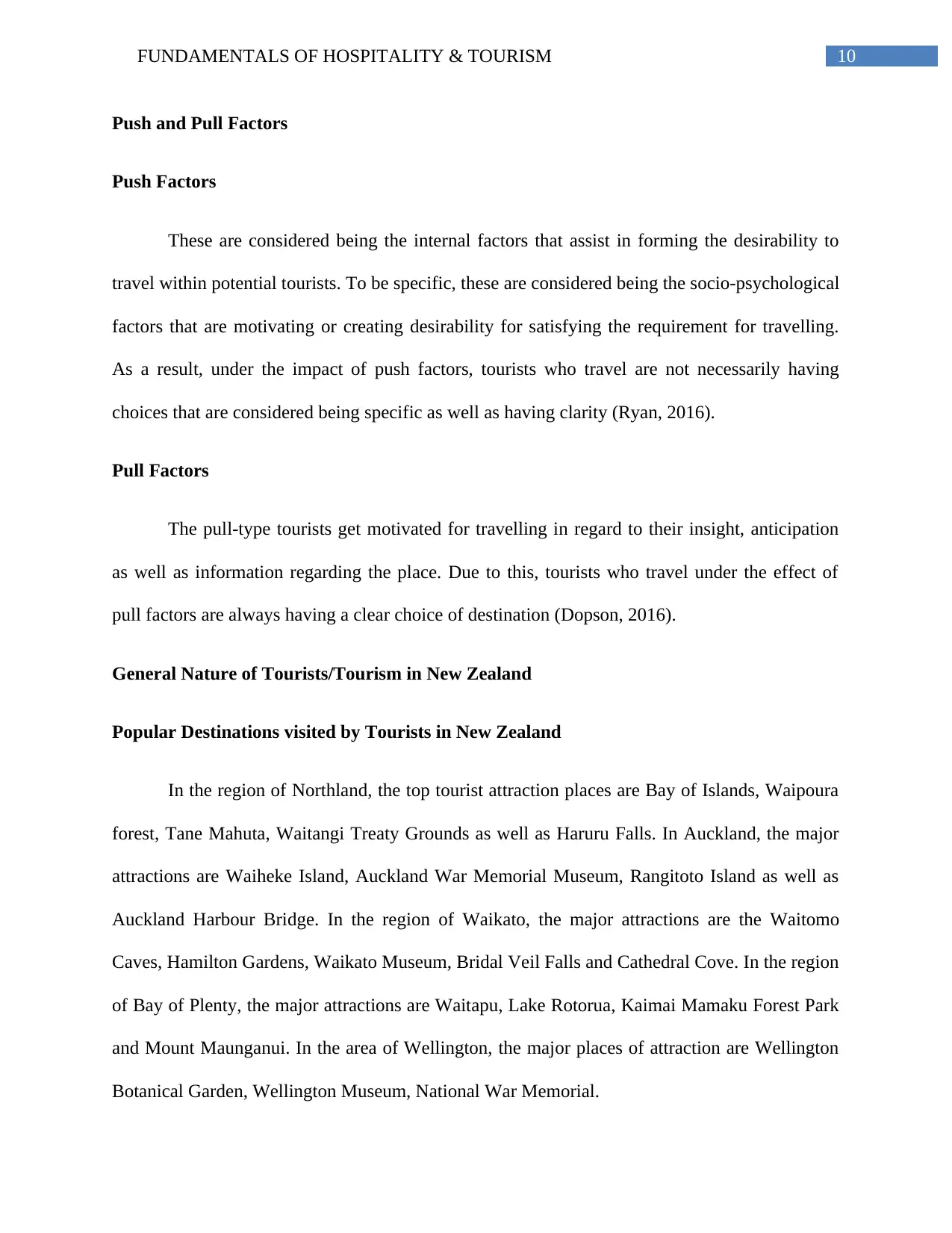
10FUNDAMENTALS OF HOSPITALITY & TOURISM
Push and Pull Factors
Push Factors
These are considered being the internal factors that assist in forming the desirability to
travel within potential tourists. To be specific, these are considered being the socio-psychological
factors that are motivating or creating desirability for satisfying the requirement for travelling.
As a result, under the impact of push factors, tourists who travel are not necessarily having
choices that are considered being specific as well as having clarity (Ryan, 2016).
Pull Factors
The pull-type tourists get motivated for travelling in regard to their insight, anticipation
as well as information regarding the place. Due to this, tourists who travel under the effect of
pull factors are always having a clear choice of destination (Dopson, 2016).
General Nature of Tourists/Tourism in New Zealand
Popular Destinations visited by Tourists in New Zealand
In the region of Northland, the top tourist attraction places are Bay of Islands, Waipoura
forest, Tane Mahuta, Waitangi Treaty Grounds as well as Haruru Falls. In Auckland, the major
attractions are Waiheke Island, Auckland War Memorial Museum, Rangitoto Island as well as
Auckland Harbour Bridge. In the region of Waikato, the major attractions are the Waitomo
Caves, Hamilton Gardens, Waikato Museum, Bridal Veil Falls and Cathedral Cove. In the region
of Bay of Plenty, the major attractions are Waitapu, Lake Rotorua, Kaimai Mamaku Forest Park
and Mount Maunganui. In the area of Wellington, the major places of attraction are Wellington
Botanical Garden, Wellington Museum, National War Memorial.
Push and Pull Factors
Push Factors
These are considered being the internal factors that assist in forming the desirability to
travel within potential tourists. To be specific, these are considered being the socio-psychological
factors that are motivating or creating desirability for satisfying the requirement for travelling.
As a result, under the impact of push factors, tourists who travel are not necessarily having
choices that are considered being specific as well as having clarity (Ryan, 2016).
Pull Factors
The pull-type tourists get motivated for travelling in regard to their insight, anticipation
as well as information regarding the place. Due to this, tourists who travel under the effect of
pull factors are always having a clear choice of destination (Dopson, 2016).
General Nature of Tourists/Tourism in New Zealand
Popular Destinations visited by Tourists in New Zealand
In the region of Northland, the top tourist attraction places are Bay of Islands, Waipoura
forest, Tane Mahuta, Waitangi Treaty Grounds as well as Haruru Falls. In Auckland, the major
attractions are Waiheke Island, Auckland War Memorial Museum, Rangitoto Island as well as
Auckland Harbour Bridge. In the region of Waikato, the major attractions are the Waitomo
Caves, Hamilton Gardens, Waikato Museum, Bridal Veil Falls and Cathedral Cove. In the region
of Bay of Plenty, the major attractions are Waitapu, Lake Rotorua, Kaimai Mamaku Forest Park
and Mount Maunganui. In the area of Wellington, the major places of attraction are Wellington
Botanical Garden, Wellington Museum, National War Memorial.
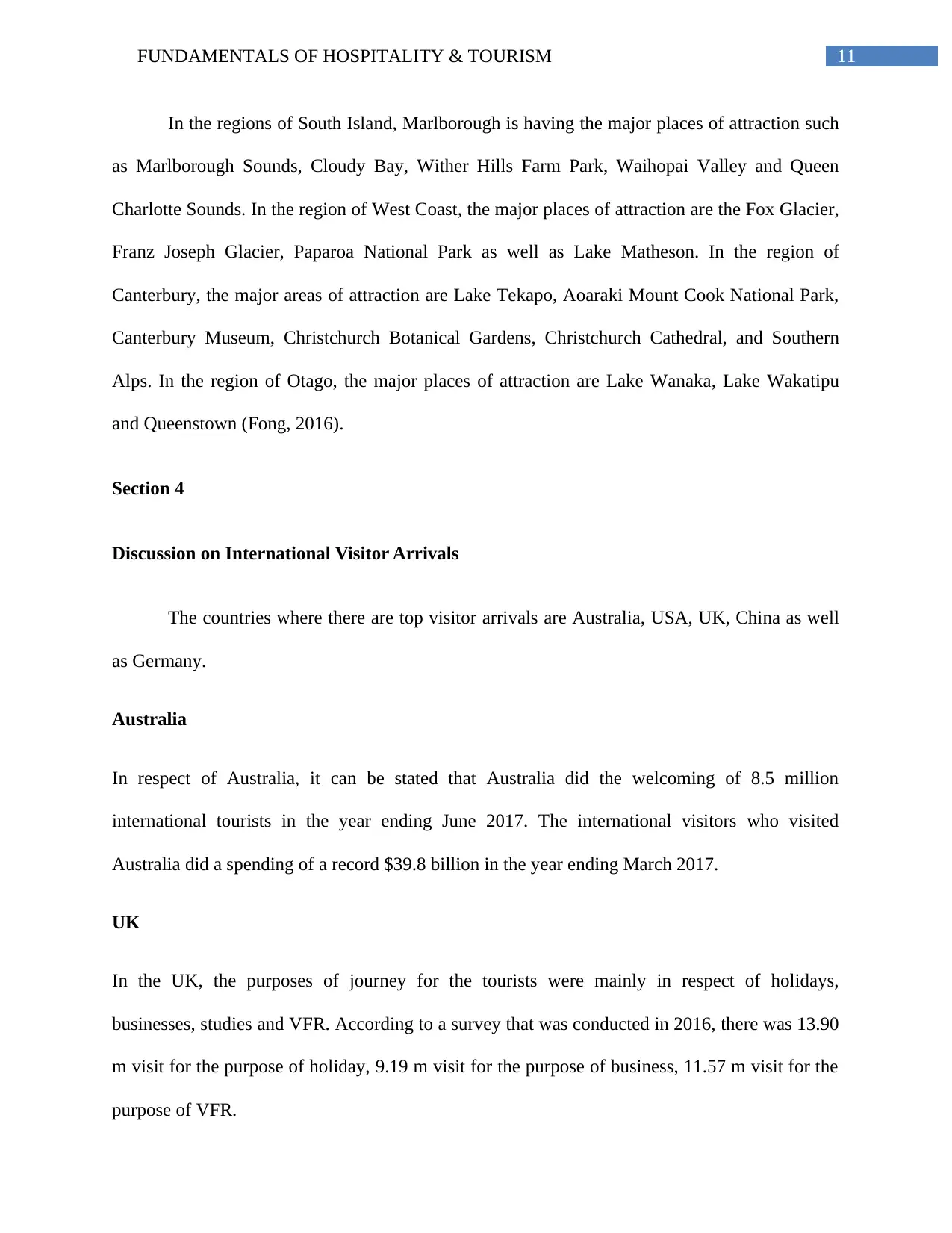
11FUNDAMENTALS OF HOSPITALITY & TOURISM
In the regions of South Island, Marlborough is having the major places of attraction such
as Marlborough Sounds, Cloudy Bay, Wither Hills Farm Park, Waihopai Valley and Queen
Charlotte Sounds. In the region of West Coast, the major places of attraction are the Fox Glacier,
Franz Joseph Glacier, Paparoa National Park as well as Lake Matheson. In the region of
Canterbury, the major areas of attraction are Lake Tekapo, Aoaraki Mount Cook National Park,
Canterbury Museum, Christchurch Botanical Gardens, Christchurch Cathedral, and Southern
Alps. In the region of Otago, the major places of attraction are Lake Wanaka, Lake Wakatipu
and Queenstown (Fong, 2016).
Section 4
Discussion on International Visitor Arrivals
The countries where there are top visitor arrivals are Australia, USA, UK, China as well
as Germany.
Australia
In respect of Australia, it can be stated that Australia did the welcoming of 8.5 million
international tourists in the year ending June 2017. The international visitors who visited
Australia did a spending of a record $39.8 billion in the year ending March 2017.
UK
In the UK, the purposes of journey for the tourists were mainly in respect of holidays,
businesses, studies and VFR. According to a survey that was conducted in 2016, there was 13.90
m visit for the purpose of holiday, 9.19 m visit for the purpose of business, 11.57 m visit for the
purpose of VFR.
In the regions of South Island, Marlborough is having the major places of attraction such
as Marlborough Sounds, Cloudy Bay, Wither Hills Farm Park, Waihopai Valley and Queen
Charlotte Sounds. In the region of West Coast, the major places of attraction are the Fox Glacier,
Franz Joseph Glacier, Paparoa National Park as well as Lake Matheson. In the region of
Canterbury, the major areas of attraction are Lake Tekapo, Aoaraki Mount Cook National Park,
Canterbury Museum, Christchurch Botanical Gardens, Christchurch Cathedral, and Southern
Alps. In the region of Otago, the major places of attraction are Lake Wanaka, Lake Wakatipu
and Queenstown (Fong, 2016).
Section 4
Discussion on International Visitor Arrivals
The countries where there are top visitor arrivals are Australia, USA, UK, China as well
as Germany.
Australia
In respect of Australia, it can be stated that Australia did the welcoming of 8.5 million
international tourists in the year ending June 2017. The international visitors who visited
Australia did a spending of a record $39.8 billion in the year ending March 2017.
UK
In the UK, the purposes of journey for the tourists were mainly in respect of holidays,
businesses, studies and VFR. According to a survey that was conducted in 2016, there was 13.90
m visit for the purpose of holiday, 9.19 m visit for the purpose of business, 11.57 m visit for the
purpose of VFR.
⊘ This is a preview!⊘
Do you want full access?
Subscribe today to unlock all pages.

Trusted by 1+ million students worldwide
1 out of 21
Related Documents
Your All-in-One AI-Powered Toolkit for Academic Success.
+13062052269
info@desklib.com
Available 24*7 on WhatsApp / Email
![[object Object]](/_next/static/media/star-bottom.7253800d.svg)
Unlock your academic potential
Copyright © 2020–2025 A2Z Services. All Rights Reserved. Developed and managed by ZUCOL.




